#Blavatnik Building
Explore tagged Tumblr posts
Text
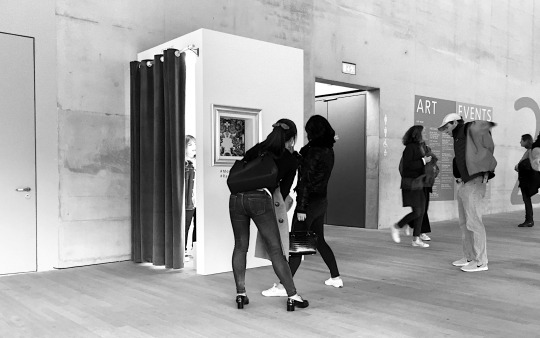
ART EVENT
#photographers on tumblr#elloon#photography#jackie branc photographer#black and white#photographer#black and white photography#social reportage#original photography on tumblr#original photographers#tate modern#Blavatnik Building
16 notes
·
View notes
Text
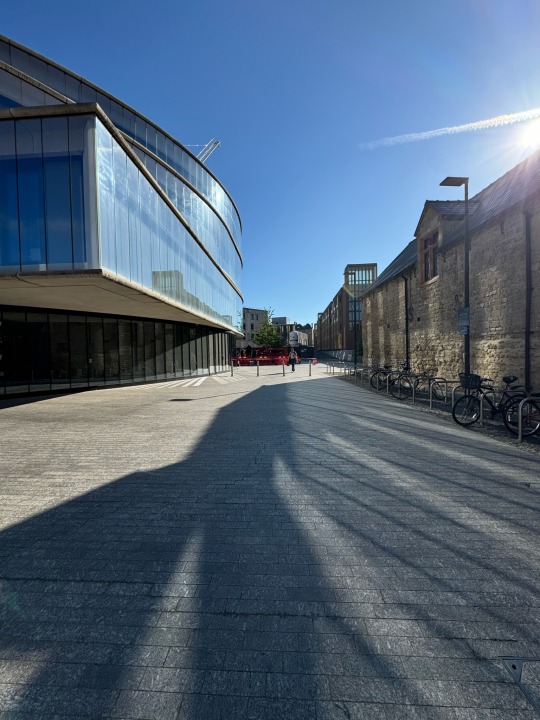
Photographer - shy-girl04 : Morning light, Oxford 2024
25 notes
·
View notes
Text
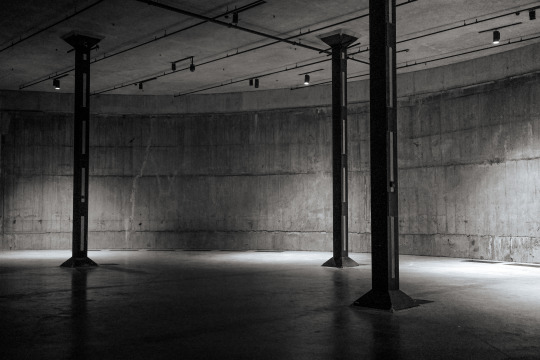
Tate Modern, Blavatnik Building
#photography#city photography#urban photography#digital photography#london#lightroom#ricoh#ricohgr3#ricohgriii#central london#ricohgriiix#Tate#Tate Modern#gallery#museum#exhibition#b&w#b&w aesthetic#b&w photography#b&w picture#black and white#original photographers#photographers on tumblr#moody#architecture#buildings#interiors#architecture photography#modern architecture#brutalist
12 notes
·
View notes
Text
silver salt & iron... act one, part one masterlist 10th February 2024 11:34am
It's Friday, and she's been working all goddamn week. The gun is surprisingly cold, next to the warmth of the light and the covers and her own body heat. Her landline rings. It's somewhere near half past eleven.
She should probably be somewhere. Her landline rings. She rips the duvet off her, and then she's cold. Shit, her landline's ringing.
She sits up, then picks it up from the bedside table. She rubs her eyes with one hand, flicking a bit of Morpheus' sand from the corner of her eye onto the solid grey carpet.
He wants her back in the office. She's barely listening after that - just the odd bit of information filters through her ears. They put some ad in the paper (Daily Express, not her favourite).
She stretches. 'Yeah, yeah. 'Kay, thanks Kat. Be there. Yeah, bye.' Kat was okay. She didn't talk to her much. A bit overbearing. Maybe a little gossipy. She's okay.
That cold gun's back in her hand. She turns it around, checks it's alright, properly oiled, all that (she'd be using this one for a good while, it had good balance, if a bit rusted. Good with her bullets though, silver and iron).
She puts it down again, satisfied. Her hands are a little chilly, so she rubs them together to warm them. Can't afford to put the heating on. More important things. She'll be going in a minute anyway.
Pulling on her shirt and a trouser leg at a time, she checks the landline's messages. Just the landlord. She puts it down and let's it play, looping her belt through the black trousers she picked out (it was a hard choice, with all the other pairs of black trousers she has).
Hey, mate. How are you?
She gets the box from under her bed, puts it on her mattress and takes three flares (low chemical reaction, low rubble), three salt oils (medium salt, high oils (so as to not rust so much)) and a plain leather scabbard and attached them methodically to her belt. She takes her rapier from the rack on the incredibly plain wall (there was, of course, the sort of artwork you get in a rented place when you're first there but it was so neutral she didn't count it as decoration).
She sits back down. I sit back down. I'm tired. I could take the tube. I didn't have enough money to get a taxi. I should save money. I didn't want to save money.
I won't have to, soon. It'll be pay day eventually. I find myself sighing. Tube it is.
I could go now, and get off at Lavington Street instead of Blackfriars or Bankside Pier, and have a walk down to Fairfax's bit of Tate Modern. Oh so caringly nicknamed the Iron Tower, although it's real name is the Blavatnik building.
Or I could have breakfast today -- one that isn't just toast and butter -- and I might feel better today. I could go down to that little coffee shop down the corner. I have been craving croissants.
Both include walking in the chilly air of London's streets. And only one includes food. I walk down to the cafe.
It's only when I sit down that I realise how tired I really am. I might be able to sleep on the tube -- if I go to St Paul's, it shouldn't be so busy. I shouldn't -- this might be important, I think, and immediately doubt it. Wouldn't wanna miss my stop.
༻🕱༺
#anthony lockwood x reader#anthony lockwood#lockwood & co.#lockwood and co#save lockwood and co#lockwood netflix#george karim#lucy carlyle#canon compliant#quite-happy
11 notes
·
View notes
Text
Things that caught my eye on today’s postbox bagging walk:
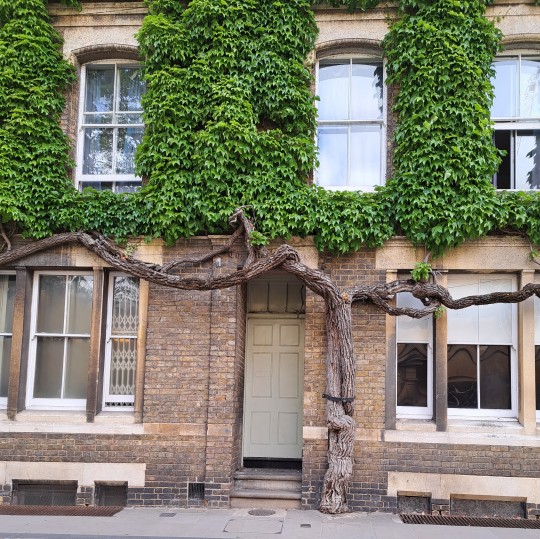
This tree’s been growing across the frontage of this building for YEARS!
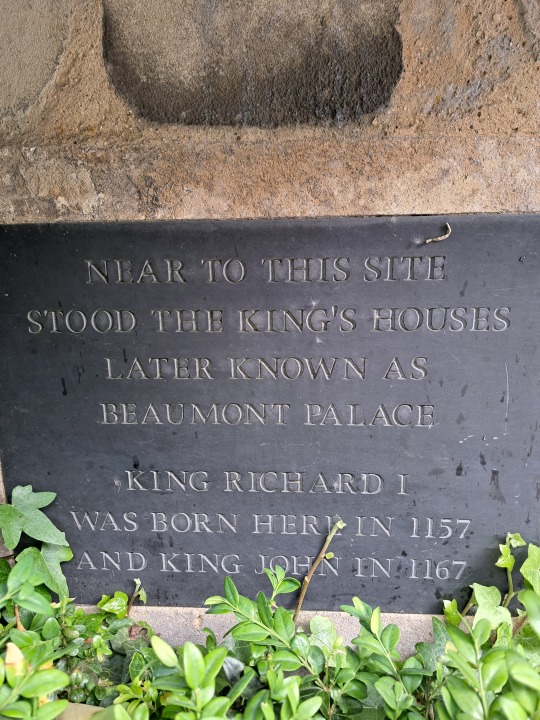
This wall plaque reads: Near to this site stood the King’s houses later known as Beaumont Palace. King Richard I was born here in 1157 and King John in 1167.
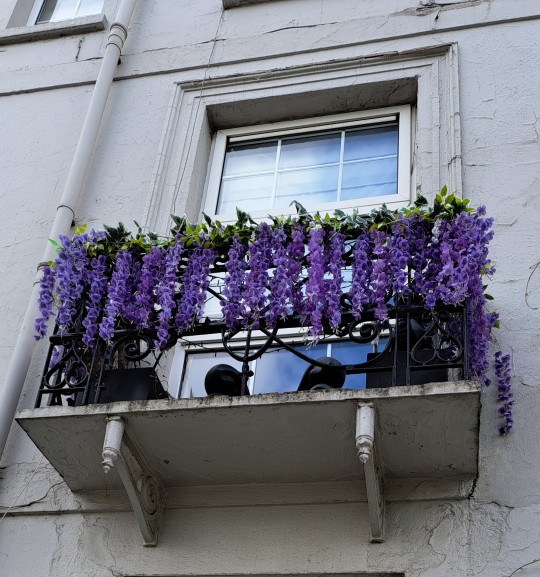
Love the Wisteria trained around this tiny metal balcony!
And over the window of the basement flat in the same building:
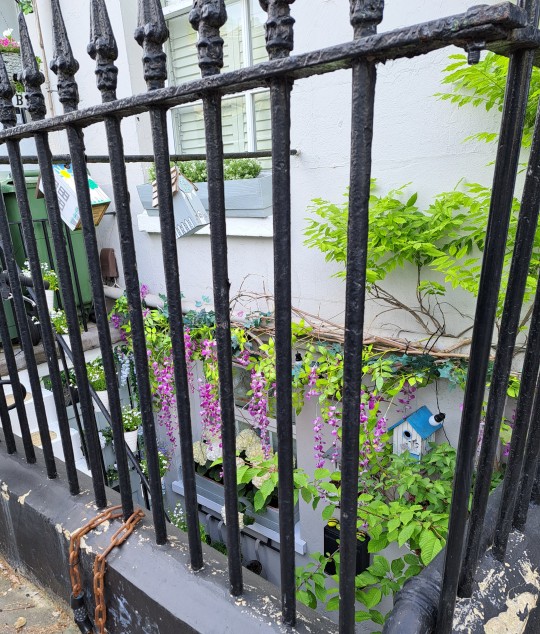
Note the bird nesting boxes - a blue and white one on the wall and two more attached to the metal pole above the steps down to the basement flat.
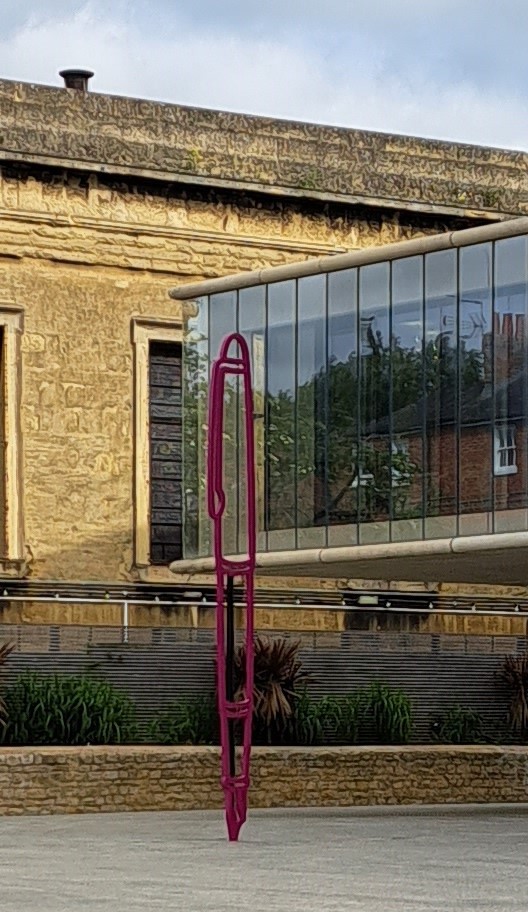
Giant pink metal sculpture of a fountain pen outside the Blavatnik School of Government.

I’m immensely curious about why Union Street was renamed Hart Street! I’ve never seen a street sign like this before - with the smaller sign saying ‘Late Union Street’ beneath the new/current street sign.
Anyway, I walked just over 2 miles in a very strong cold wind that made me wish I’d worn a coat over the three layers I was already wearing, because Brr!!
7 notes
·
View notes
Text

Tate Modern Blavatnik Building
1 note
·
View note
Text
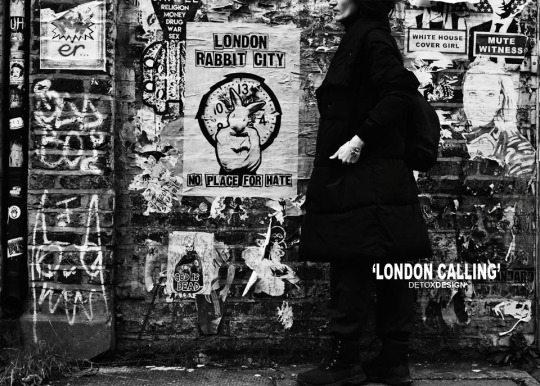
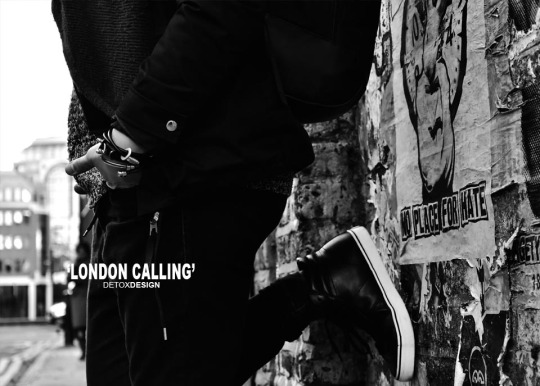












Warto Wam pokazać jak nasza autorska biżuteria zachwyciła Londyn. Tak, mamy świadomość, że nie każdy docenia i odnajduje się w Londynie. Dla nas niewiarygodna różnorodność Londynu to habitat, w którym odnajdujemy się doskonale. A projektowane przez nas bransoletki, naszyjniki, kolczyki i pierścionki wyglądają niezmiennie obłędnie gdy w tle jest to niesamowite, klimatyczne, tętniące i różnorodne miasto. Niezwykłe miasto. Jak niezwykła jest nasza designerska biżuteria, którą projektujemy dla Was. Miasto gdzie można znaleźć z jednej strony świeży, intrygujący i pulsujący szeroko rozumiany underground. Nowe i odważne myślenie i postrzeganie w sztuce, muzyce, grafice, filmie, w postawach społecznych i wielu, wielu innych aspektach. A na drugim biegunie „high end” historię, kulturę, sztukę, architekturę i znów wiele, wiele innych w możliwie najlepszej i szlachetnej formie. No i Londyn zachwyca nas za każdym razem, gdy do niego przyjeżdżamy. Aż pewnego razu to nasza autorska biżuteria zachwyciła Londyn. Bo oryginalna i modna biżuteria autorska, która czeka na Was gdy odwiedzicie najlepszy modny butik w Warszawie, nasz butik autorski na ulicy Dobra 13 zachwyca Warszawę tak jak na prestiżowej sesji fotograficznej ta zjawiskowa autorska biżuteria zachwyciła Londyn. Oto zdjęcia z naszej kultowej już sesji 'London Calling'. Więcej zdj��ć czeka na Was w naszym sklepie internetowym. A oryginalna modna biżuteria autorska dostępna online i w naszym butiku. Miłego oglądania i miłego noszenia!
Nasza sesja London Calling zachwyca Was tak jak nasza autorska biżuteria zachwyciła Londyn.
Zastanawialiśmy się w jakich plenerach nasze oryginalne bransoletki, nasze oryginalne kolczyki, oryginalne pierścionki i oryginalne naszyjniki będą wyglądać tu najlepiej. W oszołomieniu ogromem pochłanianych wrażeń stwierdziliśmy, że… wszędzie 🙂 Wcale to nie ułatwiało sprawy bo niezwykle ciężko było wybrać te najlepsze plenery. Sam ich wybór to przecież jeszcze nie sukces bo tym jest udana w efekcie końcowym sesja fotograficzna. Sukcesem są takie zdjęcia, które Was zachwycą. Wybór pleneru to tylko pierwszy mały krok. A już ten pierwszy krok, przez bogactwo możliwości był niesamowicie trudny. Trudne decyzje, rozmowy, nasze burze mózgów. Naprawdę nie było łatwo. Do momentu kiedy stwierdziliśmy: hej, zawsze możemy tu jeszcze wrócić! Na pewno tu jeszcze nie raz wrócimy! I będzie z nami nasza autorska biżuteria oryginalna bo chcemy aby Londyn zachwyciła jeszcze nie raz. A te wszystkie pozostałe i nie wykorzystane niesamowite plenery będą dodatkowym pretekstem.
Wtedy pojawiłam się w nas ulga a w naszych głowach przestrzeń. Pojawił się ten rodzaj skupienia i lekkości, które są konieczne by znaleźć szczególny punkt pomiędzy uwolnioną improwizacją a skupionym studium. Upragniony punkt, w którym tworzymy najlepiej a efekt działania zachwyca. To gdzie pojawiła się nasza oryginalna modna biżuteria autorska w fotograficznych sesjach? Na jakim tle możecie oglądać w efekcie naszych fotograficznych sesji nasze autorskie bransoletki, autorskie kolczyki, nasze autorskie pierścionki i autorskie naszyjniki? Gdzie nasza autorska biżuteria zachwyciła Londyn?
To miasto niezwykłe tym bardziej jesteśmy dumni, że nasza autorska biżuteria zachwyciła Londyn kolejny raz. Zupełnie zmieniona i jeszcze bardziej zapierająca dech w piersiach Liverpool Street. Niesamowita dzielnica Shoreditch imponująca różnorodnością miejsca na pograniczu tak różnych światów jak biznes o światowym zasięgu, awangarda sztuki. egzotyka z najdalszych zakątków świata. Kultowa, zasłużenie współczesna świątynia i maszyna jednocześnie jaką jest kochana za swoją niewiarygodnie gościnną i przyjazną atmosferę Tate Modern. Z jej imponującą halą turbin i nowym skrzydłem „Blavatnik Building” autorstwa genialnego duetu Jacques Hercog + Pierre de Meuron. Nowe skrzydło zachwyca najwyższej jakości współczesną architekturą i mistrzowskim rzemieślniczo wykonanymi ceglanymi fasadami. W samym Tate Modern dowolne miejsce jest niesamowicie fotogeniczne. Każda klatka schodowa, toaleta, każda galeria widokowa. Oczywiście centralna przestrzeń hali turbin czy wreszcie przestrzenie sal ekspozycyjnych z niesamowitymi zbiorami sztuki współczesnej. Z między innymi dziełami naszych ukochanych gigantów takich jak Rothko czy Gormley.
Zeszliśmy dla Was również pod ziemię. 🙂 Londyńskie „tube” to też niesamowity plener i również w jego przestrzeniach nasza autorska biżuteria zachwyciła Londyn. Nasze industrialne bransoletki, oryginalne pierścionki, lekkie kolczyki i proste naszyjniki miały doskonałe, klimatyczne i niesamowicie fotogeniczne tło.
My jeszcze do Londynu wrócimy wielokrotnie! I Wy jeszcze wielokrotnie odwiedzicie swoje ukochane miejsca na ziemi. I będzie tam z Wami ukochana Wasza najchętniej noszona oryginalna biżuteria. Będą tam Wasze ukochane i zawsze modne bransoletki, modne kolczyki, modne naszyjniki i modne pierścionki. I będzie z Wami wiele naszych wzorów. My nie przestaniemy dla Was projektować ponieważ tak bardzo to kochamy! No i po tym jak nasza autorska biżuteria zachwyciła Londyn mamy jeszcze jeden argument, prawda? Choć Wasz zachwyt zawsze pozostanie dla nas najważniejszy. LOVE!!!
#moda#butik#fashion#love#life#detoxdesign#biżuteria#bransoletki#modna biżuteria#biżuteria autorska#industrialne naszyjniki#naszyjniki warszawa#naszyjniki autorskie#oryginalne naszyjniki#modne naszyjniki#nowe pierścionki#pierścionki autorskie#modne pierścionki#modne kolczyki#nowe kolczyki#kolczyki#londyn#london#photography#fashiondesigner#fashion photography
0 notes
Text

Pergi ke Blavatnik Building
Mengunjungi Victoria and Albert Museum
Menonton pertandingan bola di Stamford Bridge
0 notes
Text
How Does The Mind Make Decisions
Mouse study provides insight into communication between neurons during decision-making
•Research reveals how neurons in the brain are wired to help a mouse make decisions.
•The findings suggest that different sets of neurons work together to solidify choices.
•The study establishes how specific connections between neurons in the brain support decisions-making.
Scientists have gained new insights into how neurons in the brain communicate during decision, and how the connections between neurons may help reinforce a choice.
The study-conducted in mice and led by neuroscientists at Harvard Medical School-is the first to combine structural, functional, and behavioral analyses to explore how neurons-to-neuron connections support decisions-making.
Findings appear in nature
"How the brain is organized to help make decisions is a big, fundamental question, and the neural circuitry-how neurons are connected to one another-in brain areas that are important for decisions-making isn't well understood," said Wei-Chung Allen Lee, associate professor of neurobiology in the Blavatnik Institute at HMS and professor of neurology at Boston Children's Hospital. Lee is co-senior author on the with Christopher Harvey , professor of neurobiology at HMS, and Stefano Panzeri professor at University Medical Center Hamburg-Eppendorf.
In the research, mice tasked with choosing which way to go in a maze to find a reward. The researchers found that a mouse's decisions to go left or right activated sequential groups of neurons, culminating in the suppression of neurons linked to the opposite choice.These specific connections between groups of neurons may help sculp decision by shutting down neural pathways for alternative options Lee said.
A fruit collaboration is born
It was a chance on a bench outside their building during a fire drill that led Harvey and Lee to realize the complementary nature of their work. On that day, they forged a collaboration that propelled the new work.
The Harvey lab uses mice to study behavioral and functional aspects of decision-making. Typical experiments involve placing a mouse in a virtual reality maze and recording neural activity as it makes decisions. Such experiments have shown that distinct, but intermingled, sets of neurons fire when an animal chooses left versus right.
Lee works in new field of neuroscience called connectomics, which aims to comprehensive map connections between neurons in the brain. The goal, he said, is to figure out "which neurons are talking to each other, and how neurons are organized into networks."
By combining their expertise, Harvey and Lee were able to delve deeper into the different types of neurons involved in decision-making and how these neurons are connected.
Choosing a direction
The new study focused on a region of the brain called the posterior parietal cortex-what Lee describes as "integrative hub" that receives and processes information gathered by multiple senses to help animals make decisions."
The Harvey lab recorded neural activity as mice ran a T-shaped maze in virtual reality. A cue, which happened several seconds beforehand, indicated to the mice whether a reward would be in the left or right arm of the T-shaped maze. The Lee lab used powerful microscopes to map the structural connections between the same neurons recorded during the maze task.
By combining modalities, the researchers distinguished excitatory neurons-those that activate other cells-from inhibitory neurons, which suppress other cells. They found that a specific set of excitatory neurons fired when a mouse decided to turn right, and these "right turn" neurons activated a set of inhibitory neurons that curbed activity in "left-turn" neurons. The opposite was true when a mouse decided to turn left.
"As the animal is expressing one choice, the wiring of the neuron circuit may help stabilize that choice by suppressing other choices," Lee said. "This could be a mechanism that helps an animal maintain a decision and prevents changes of mind.
The findings need to be confirmed in humans, although Lee expects that there is some conservation across species
The researchers see many directions for future research. One is exploring the connections between neurons involved in decision-making in other brain regions.
We used these combined experimental techniques to find one rule of connectivity, and now we want to find others," Lee said.
0 notes
Text
Building Models of the Brain to Take Them Apart - Technology Org
New Post has been published on https://thedigitalinsider.com/building-models-of-the-brain-to-take-them-apart-technology-org/
Building Models of the Brain to Take Them Apart - Technology Org
Computational neuroscientist probes how the brain learns, remembers, and decides.
Kanaka Rajan describes herself as an ever-curious, “stick-my-finger-in-the-electrical-socket kind of person” who enjoys working with her hands. Forays into engineering and experimental neuroscience led Rajan to her true calling: computational neuroscience.
Visual media can increase engagement and retention of difficult topics. Rajan has been working with visual artists and science communicators to create science comics that explain her research. These comics aim to make complicated subjects in computational neuroscience accessible to a broad audience by breaking them down into digestible pieces. They achieve this by conveying scientific findings through compelling visuals that avoid scientific jargon, thus lowering the barrier to entry in technical fields. The National Science Foundation and the Mindlin Foundation support the work. Image credit: Jorge Cham. Courtesy of Rajan lab
Rajan spends her time building and manipulating models of the brain — an approach that affords her a great deal of freedom. One day she may be modeling complex social behavior in mice, and the next mapping neuronal connections in an octopus brain.
“My energy comes from that freedom; I basically see everything as a rich source of problems,” said Rajan, who in September became an associate professor of neurobiology in the Blavatnik Institute at Harvard Medical School. She is also a founding faculty member of the Kempner Institute for the Study of Natural and Artificial Intelligence at Harvard University.
In a conversation with Harvard Medicine News, Rajan spoke about her wide-ranging research, her interest in science communication, and why she’s excited to join the Kempner.
HMNews: What do you study and why?
Rajan: I want to understand how animals and humans learn, remember, and make decisions. To do this, I use tools from mathematics, physics, and engineering, including artificial intelligence, to build models of different brains that are as close as possible to the learning and deciding of real brains. The advantage of building a model is that we have access to all the pieces, so we can take it apart in ways we cannot take an actual brain apart, which allows us to identify core operating principles that may exist in the biological system. The overarching goal of this work is to understand the foundations of natural and artificial intelligence: What makes us sentient? What makes us “us”?
HMNews: When you talk about brain models, what do you mean?
Rajan: These are computational models, or artificial “facsimiles” of real brain circuits. Sometimes they are computer simulations and sometimes they are mathematical equations. A model is like an unformed block of clay: it consists of equations and mathematical terms that we sculpt using our knowledge of the biological system until it resembles the real brain or behavior. Then, we take that model to colleagues in experimental neurobiology and compare it to the system or behavior it was designed to copy. As a result, I work closely with experimentalists in everything that I do. It’s an iterative process of going back and forth between models and experiments.
HMNews: How are you using these computational models in your research?
Rajan: One area is building models that are constrained by biological data. Experimentalists are collecting more and more data from the brain as they’ve progressed from recording activity in single neurons to entire brain regions. As a result, we’re faced with the problem of trying to organize and make sense of huge amounts of data — which is where models come in. For example, I’ve worked with an experimentalist who can image the activity of neurons in the entire brain of larval zebrafish. Using this information, I built a model that essentially replicates the fish brain and we figured out how neurons communicate within and across brain areas while the animal is “just hanging out.” We can use a model like mine to design new experiments, including drug screens.
HMNews: How else are you applying models in your work?
Rajan: I have another project that focuses on learning trajectories — work that is relevant to education. When we think about how we learn math, for example, we don’t just memorize formulas and equations. Instead, we learn addition, then we progress to multiplication, then we build these skills into formulas and equations. In other words, we break the subject down into conceptual building blocks that we stack on top of one another. We do this until we get good at the more complex skill and at using the various concepts we learned along the way.
In my research, rather than looking at “expert” animals — mice that are already experts at navigating a maze, for example — and trying to reverse engineer their learning process, we explicitly model the entire learning trajectory. We compare our model to experimental data collected during training to ask basic questions about how tasks are broken down into conceptual building blocks. Models like mine provide a roadmap for how animals learn different tasks, which we hope will help us understand how humans learn subjects such as math and music, and how to improve learning across domains. This may be relevant for people with traumatic brain injuries who need to relearn basic skills.
HMNews: What new areas of research are you excited to pursue at HMS?
Rajan: I am especially excited about a more out-there project on the neural mechanisms responsible for the emergence and stabilization of social groups. Many neurobiology labs interested in social neuroscience are looking at brain activity in pairs of animals interacting. Their data sets are large and rich, but two animals can interact in only a few ways. By contrast, physicists look at collective behavior in large ensembles of animals such as flocks of birds or schools of fish. They build elegant mathematical models, but those models essentially treat each animal in a group as a particle rather than as an individual with complex behaviours.
My lab thinks there may be an optimal, more informative zone in the middle of these extremes, between three and 10 animals. People in evolutionary and developmental biology and neuroeconomics have observed that 10 seems to be the threshold for the nervous system’s ability to process complex information from multiple members. We want to understand why this may be the case.
To this end, we’re building computer programs that contain artificial agents — think video game avatars of animals — that we force to interact socially in different digital environments. For example, we have mouse avatars forage in an environment with trees and bushes as we add elements like predators, obstacles, or droughts. We can then ask experimentalists to run lab experiments with actual mice interacting in similar situations and compare the data.
HMNews: Do you think this project will tell us anything about humans?
Rajan: We hope to use our model to simulate human social concepts like loneliness. For example, if a mouse avatar that was social becomes isolated, does it show similar deficits that a profoundly, chronically lonely person showed during the COVID-19 pandemic? Does it now have trouble reentering society? Loneliness is an epidemic and a documented precursor to many neurologic and neurodegenerative disorders. We need to understand the neural basis of social interactions so that we can begin to develop interventions for the human condition.
Image credit: Matteo Farinella, Rajan lab
HMNews: You recently joined HMS, but you will also be working at the Kempner. What attracted you to the institute?
Rajan: I came to computational neuroscience circuitously; I started off in engineering and moved to biology in graduate school, thinking that I wanted to be an experimentalist. Eventually, I realized that I wanted to be in a field that merges the two, but to do that, I needed to learn both the language of quantitative analysis and the language of biology, which took a long time. Institutions like the Kempner will speed up this process by providing the tools and a physical location where everybody can come together: animal researchers, engineers, coders, basic biologists, and people like me who have always wanted to exist between fields. The Kempner is saying to me and to the next generations of young minds that we don’t care about traditional labels. We just want you to study big, interesting problems and we will teach you whatever languages you need, and provide you with whatever resources you need.
Image credit: Jordan Collver. Courtesy of Rajan lab
HMNews: You are also interested in science communication. Why?
Rajan: In computational neuroscience, we’ve created high barriers to entry because it may be convenient at times. I believe these barriers are completely made up. I’ve come to realize that you don’t need an advanced degree in math to be a computational neuroscientist. You don’t need to be the world’s best programmer to quickly ramp up to a research problem. We have taken on the biggest question facing humanity — how the brain works — and we need as many brains as possible to answer it. If we keep writing inscrutable papers, we silo knowledge away from those who can help. If we don’t learn how to communicate clearly in a jargon-free manner, and if we don’t lower the barrier to entry, my field will miss out on promising talent and radical new ideas, including from groups that have been historically underrepresented and marginalized. How I communicate what I do to students at all levels is as important as what I do.
Visual media have been shown to increase engagement and retention of hard topics, so my lab began creating science comics. We turn content from scientific papers into comic strips that we distribute to underserved high school students, with the goal of promoting discussions about the papers. I hope that by making computational neuroscience more accessible, we can eventually help the field become more inclusive and diverse.
Source: HMS
You can offer your link to a page which is relevant to the topic of this post.
#Analysis#Animals#approach#artificial#Artificial Intelligence#artists#avatar#avatars#barrier#Behavior#Biology#Biometrics news#Biotechnology news#birds#Brain#brain activity#brain development#brain injuries#brains#Building#Collective#communication#Computational biology#computer#covid#data#deal#Design#disorders#domains
0 notes
Text

Photographer - shy-girl04 : Steps, Oxford 2024
23 notes
·
View notes
Video
youtube
The Egyptian army begins constructing dirt berms on Egypt’s borders with Gaza, the disappearance of Abu Ubaida, and a dangerous leak to Netanyahu. Updates on the Al-Aqsa Flood operation presented in this episode of Samri Channel. Starting with the British newspaper the Financial Times, which quoted military analysts as saying that the extent of the destruction in Gaza is equal to what was completely destroyed in all German cities during World War II. The newspaper said in a report titled “Israeli bombs raining on Gaza” that Benjamin Netanyahu requested more American bombs to destroy Hamas, as it described it. The newspaper added that Netanyahu told a group of local government officials, according to a recording obtained by the “Israel Hayom” newspaper: “We need three things from the United States: munitions, munitions, and munitions.”
Military analysts told the newspaper, citing estimates of damage to urban areas, that the devastation inflicted on northern Gaza in less than seven weeks is close to the devastation caused by the massive bombing of German cities over years during World War II. “Gaza will also be included as a place name that refers to one of the heaviest conventional bombing campaigns in history,” said Robert Pape, an American military historian and author of “Bombing to Win.” The newspaper pointed out that, in contrast, over the course of two years, between 1943 and 1945, the Allied bombing of 61 major German cities led to the destruction of an estimated 50% of their urban areas, according to Babe. A 1954 US military review estimated that 7,100 tons of Allied munitions were dropped on Dresden, severely damaging 56% of non-industrial buildings, half the homes, and killing about 25,000 people. The newspaper pointed out that one of the reasons for the extent of the destruction is the munitions used by the Zionist entity. The Israeli occupation army did not publish public information, but the pictures it publishes daily show its planes taking off loaded with munitions that were identified to the Financial Times by explosives experts. The newspaper said that some munitions are very accurate, which can help limit collateral damage. Among them are 250-pound precision-guided small-diameter bombs, which, because of their relatively small size, “inherently reduce the likelihood of collateral damage,” according to the US Air Force. The attack helicopters also carried laser-guided “Hellfire” missiles, the mainstay of American urban combat against ISIS fighters in Iraq and Syria, and “fire-and-forget” Spike missiles, traditionally Israel’s weapon of choice for precise, targeted killings.
The newspaper spoke with Janina Dale, professor of global security at the Blavatnik School of Government at the University of Oxford, where she said: “It is striking how many times the Israeli army was able to obtain bombs weighing 2,000 pounds.” For his part, Mark Garlasko, a military advisor to the Dutch organization PAX and a former intelligence analyst at the Pentagon, said, “The power of these bombs, enhanced by a global positioning system that turns them into “smart bombs” or so-called Joint Direct Attack Munitions (JDAMs), is so enormous that even the survivors From the explosion they said they felt like they were “surfing on liquid Earth.” Garlasco added that the only reason he thinks about why it is used is that the Israeli occupation army is allegedly trying to destroy Hamas’s tunnel network.”
He continued, saying: “But what is striking is its widespread use.” Military analysts said that the second reason for the high level of destruction was the speed and intensity of the Israeli bombing campaign, as well as relaxed targeting rules that may have allowed a greater number of civilian casualties to occur. The British newspaper reported that in just the first two weeks of its campaign, the occupation army used at least 1,000 air-to-ground munitions per day, according to estimates by John Ridge, an open-source intelligence analyst and munitions expert.
The Israeli military responded by saying it would take a different approach in the south, using data to identify densely populated areas and calculate evacuation routes as well as sharing maps indicating where people should flee. More than 15,000 Gazans died before Israel began its southern offensive last week, according to Palestinian officials in the Hamas-controlled area. Israel claims this includes up to 5,000 Hamas fighters. By comparison, 12,000 civilian deaths were recorded in the first nine months of the US invasion of Iraq in 2003. “By all accounts, Gaza is already a severe campaign of civilian punishment,” said military historian Pape. “It will go down in history as one of the deadliest operations ever conducted using conventional weapons.”
On the other hand, the Sinai Foundation for Human Rights obtained special photos showing the Egyptian army forces establishing dirt berms east of the city of Rafah, and along the Egyptian border with the Gaza Strip. The Foundation, a non-governmental human rights organization, published: independent; Concerned with monitoring the human rights situation in the Sinai Peninsula, a picture of high dirt barriers, behind which buildings and communications towers appear.
#Egypt #Palestine #Gaza
0 notes
Photo

This is the observation level in Tate Modern’s Blavatnik Building, looking across the river towards St. Paul’s. You can only see thin little slivers of Big Ben, Parliament, Tower Bridge and the Tower of London because they’re mostly blocked off by offices, but the skyscrapers look good in the City and Canary Wharf.
17 notes
·
View notes
Video
Seclusion Tate Modern, Herzog & de Meuron
#Blavatnik Building#Southwark#Herzog & de Meuron#Tate Modern#UK#London#JZA Photography#London Borough
34 notes
·
View notes
Photo

Thumb piano school desk. Tate Modern, Bankside, Southwark, London, England
1 note
·
View note
Photo



Tissues, an opera by Pan Daijing in five acts, at Tate Modern, London on Oct 2nd, 4th and 5th, 2019
Queueing in the Tate Modern’s bunker-like Blavatnik Building, pre-show conversation is hushed into silence after filing into the dimly lit, cylindrical Tanks gallery. For Pan Daijing’s contemporary art opera Tissues, running on October 2, 4 and 5, classically-trained vocalists wander the space doing vocal utterances that sound like odd whale calls. Plain garments and a long lock of hair hang on the raw concrete walls. There’s enough symbolic eeriness and sonic tension here—with aesthetic allusions to horror—to suggest a dynamic and uncertain performance might follow. read more
Photo credit: Nadine Fraczkowsk
#photography#live performance#tate modern#london#2019#pan daijing#women in electronic music#nadine fraczkowsk
4 notes
·
View notes